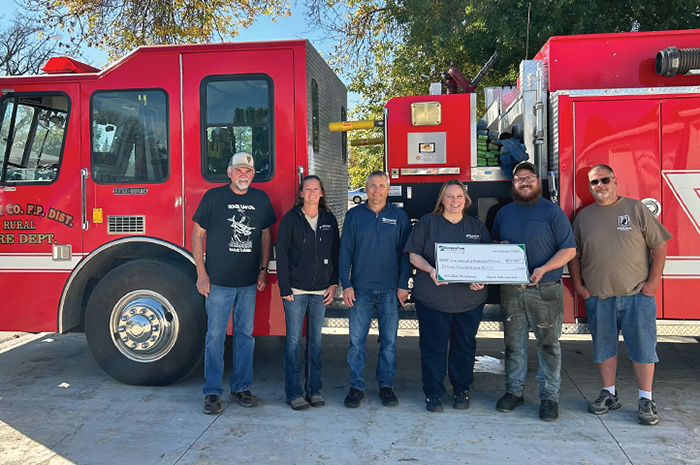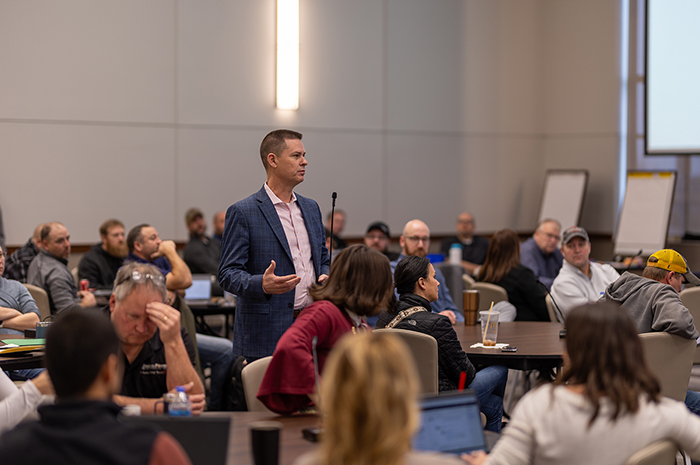Building momentum, powering tomorrow
Minnkota recently held its 85th annual meeting as the pace of industry change accelerates.
Minnkota Power Cooperative board chair Mark Habedank took his place behind the lectern on April 4, looking out onto the faces of nearly 200 co-op members, delegates, employees and industry partners. It was annual meeting morning at Minnkota’s headquarters in Grand Forks, North Dakota, and it felt as though a physical force was coursing through the crowd.
“It's always uplifting to me personally when I see this room full of people and know we're all working together on our energy future,” Habedank said from the stage. “This is our momentum, and it is built through commitment, persistence and a shared vision for the future.”
“Building Momentum, Powering Tomorrow” was the theme behind Minnkota’s 85th annual meeting, a day shared with the co-op’s business partner, Square Butte Electric Cooperative. Together, the cooperatives celebrated a remarkable 2024 – a year that brought its fair share of challenges but also demonstrated what can be wrought through teamwork and perseverance.
Habedank commended Minnkota’s workforce for recording the cooperative’s lowest rate of safety incidents, along with the receipt of a Certificate of Safety Achievement from the Rural Electric Safety Achievement Program. “Safety has been prioritized in our business plan, and this is strong evidence of staff following through on that initiative,” he said.

In 2024, Minnkota also marked its best power delivery reliability metrics in 25 years, all while successfully completing a weekslong major scheduled maintenance outage on Unit 1 of the Milton R. Young Station power plant. It was also a year of progress in shaping the co-op’s energy future. Work advanced on Project Tundra, a carbon capture initiative aimed at reducing emissions at the Young Station. At the same time, Minnkota closed a deal to expand its renewable energy portfolio by reaching an agreement to purchase power from the 370-megawatt Flickertail Wind Farm, a community-driven wind project near New Rockford, North Dakota.
Even with this positive momentum, board leadership acknowledged the steep hill yet to climb.
“As we look forward, we recognize that some of the most critical power supply decisions in our history are not only in front of us – they’re directly in front of us. We've spent six-plus years modeling. Now we need to act,” Habedank said. “We move forward with the support and guidance of our membership to make the best decisions possible.”
“Together we will continue to navigate challenges, embrace opportunities and power the future with confidence,” added Paul Aakre, president of the Square Butte Electric board. “Reliability, affordability and sustainability must be our focus.”

“What could happen in a year?’
Todd Sailer, Minnkota Vice President of Power Supply, reiterated the strength of the cooperative’s coal-powered generation fleet, which in 2024 met all local and national compliance obligations and continued to outperform others in the industry in terms of availability.
However, even with the addition of Flickertail Wind Farm, Minnkota will still need to prepare for a dramatic rise in demand. “If you go back to 2008, there really hasn't been a lot of load growth in the region, even in our system. When we do our load forecast, we consistently see roughly flat to roughly 1% load growth. That's changing,” Sailer explained, noting the onset of data centers, artificial intelligence and electric vehicles. “We're not really talking about 1% anymore. We're talking about something much higher than that – roughly 3.5%.”
At the same time load is growing, resources that have historically provided baseload power to the region have started to transition into more weather-dependent generation modes. This, combined with regularly changing industry rules and regulations, has created a difficult moving target for Sailer and his resource planning team. He indicated Minnkota will likely need to add natural gas to its portfolio to keep up with load growth within the constraints of global supply chain delays. “There’s been this idea that we were going to have to start preparing earlier for the future – I think that time is now,” he said.
As Minnkota Vice President of Power Delivery Brendan Kennelly delivered his report on transmission, he reflected on the $300 million investment that Minnkota has made in legacy infrastructure over the past decade, “not only to maintain it, but to position it for the future.” In 2024 alone, crews rebuilt 40 miles of 69-kilovolt transmission line, interconnected with the brand new Walle substation south of Grand Forks, and completed a series of upgrades to infrastructure in northwest Minnesota in partnership with Otter Tail Power Company.

“So, what did that result in?” Kennelly posed rhetorically. “I'm very happy to say we had record-setting reliability in terms of frequency of momentary outages and frequency of sustained outages. They were our lowest numbers ever at Minnkota. We're very proud of that. We'll continue that focus to push those down.”
To conclude the annual meetings, Minnkota President and CEO Mac McLennan took the stage to deliver his perspective on the state of the co-op and of the industry. He noted that the phrase “What could happen in a year?” is no longer a relevant musing for Minnkota, replaced now with “What could happen in a week?”
McLennan remarked that the cooperative has been in a “luxurious” position for the last several years – able to remain consistently long in the energy marketplace and able to invest heavily in transmission infrastructure – that has kept Minnkota from being forced to make fast choices. But that time of luxury has passed, and the cooperative must now make 30-year decisions in what feels like 30 seconds.

“We have an accelerating set of changes. We all feel it, you all see it, we all talk about it. There isn’t any place in our industry that isn’t thinking this. To manage that, part of what you have to do is get in the right spot,” he said. “I argue that the work we’ve done over the past few years … creates a foundation and the momentum to allow us to have some confidence.”
Understanding the complexity and volatility of what’s ahead, McLennan hearkened back to the earlier sentiment of his board chair: The people in the room before him would remain the catalyst for the cooperative’s momentum.
“I am blessed,” he said, meeting the gaze of those he’s worked alongside. “I am grateful for you hanging together and working together and proactively helping us find a direction forward.”
Minnkota celebrates careers of Lowell Stave and Craig Bleth

During a membership meeting preceding the annual meeting, Minnkota recognized two leaders retiring in 2025: Lowell Stave, Minnkota Vice President and Chief Operating Officer, and Craig Bleth, Minnkota Vice President of Project Development.
“There are very few people who work harder than [Lowell Stave] that I’ve ever met in my life – who care more about this program than him. And we are all better for that. And I’m forever grateful,” Minnkota CEO Mac McLennan said of Stave, continuing with words for Bleth. “He's been one of the most valuable employees I've ever had in my life. ‘Craig, can you go tackle this hill for us?’ And he's never said he can't. He's never not committed to that. And so, to both of you, I'm very, very thankful.”
Minnkota would like to thank Stave and Bleth for their years of dedication to the growth and success of the cooperative and its membership.
MAIN IMAGE: Minnkota Vice President for Power Supply Todd Sailer delivers an update on the cooperative's generation resources. (Minnkota/Michael Hoeft)
...



